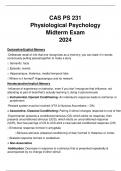Exam (elaborations)
(BU) CAS PS 231 Physiological Psychology Midterm Exam 2024
- Course
- Psychology
- Institution
- Boston University
(BU) CAS PS 231 Physiological Psychology Midterm Exam 2024(BU) CAS PS 231 Physiological Psychology Midterm Exam 2024(BU) CAS PS 231 Physiological Psychology Midterm Exam 2024(BU) CAS PS 231 Physiological Psychology Midterm Exam 2024
[Show more]



